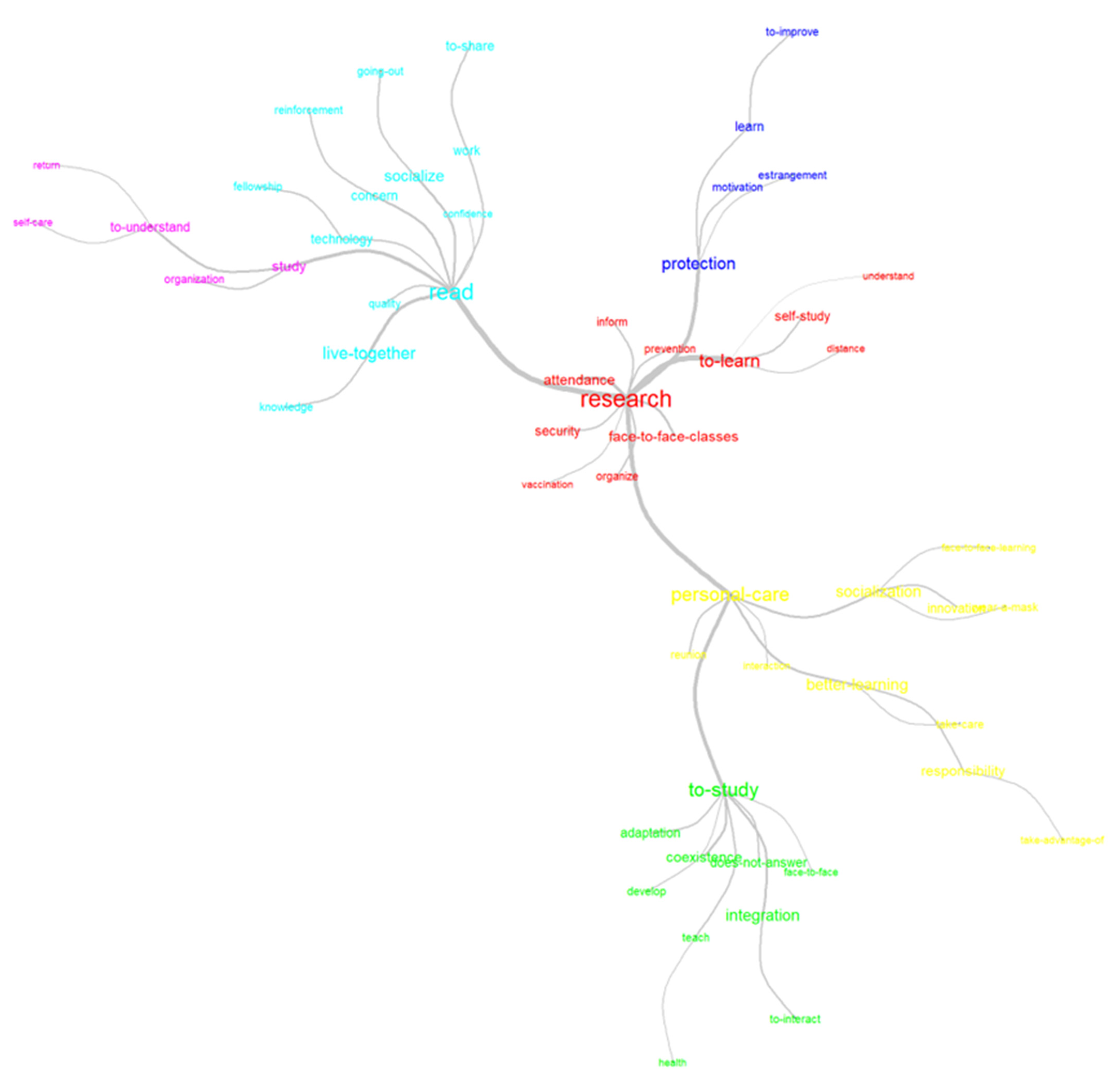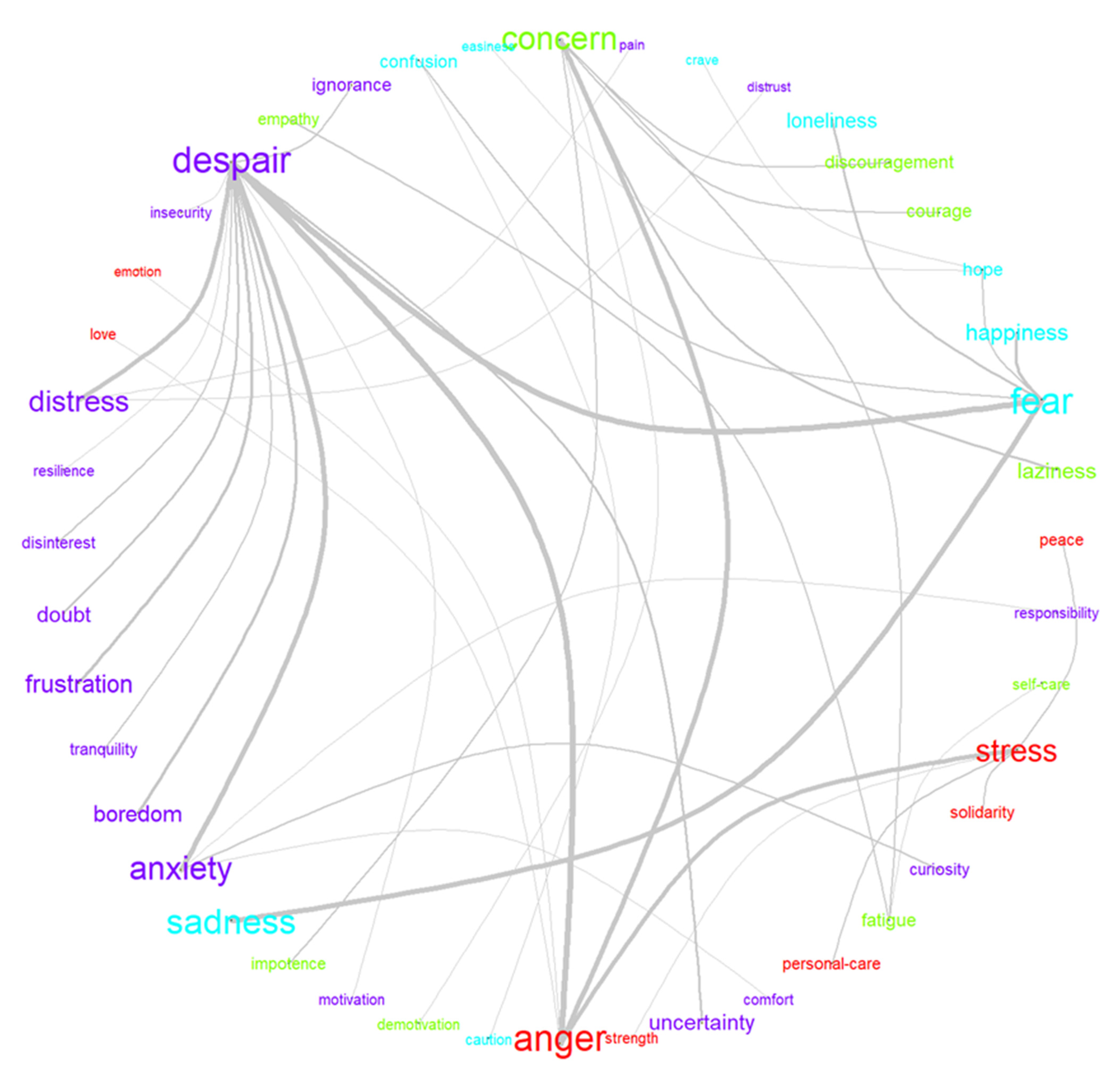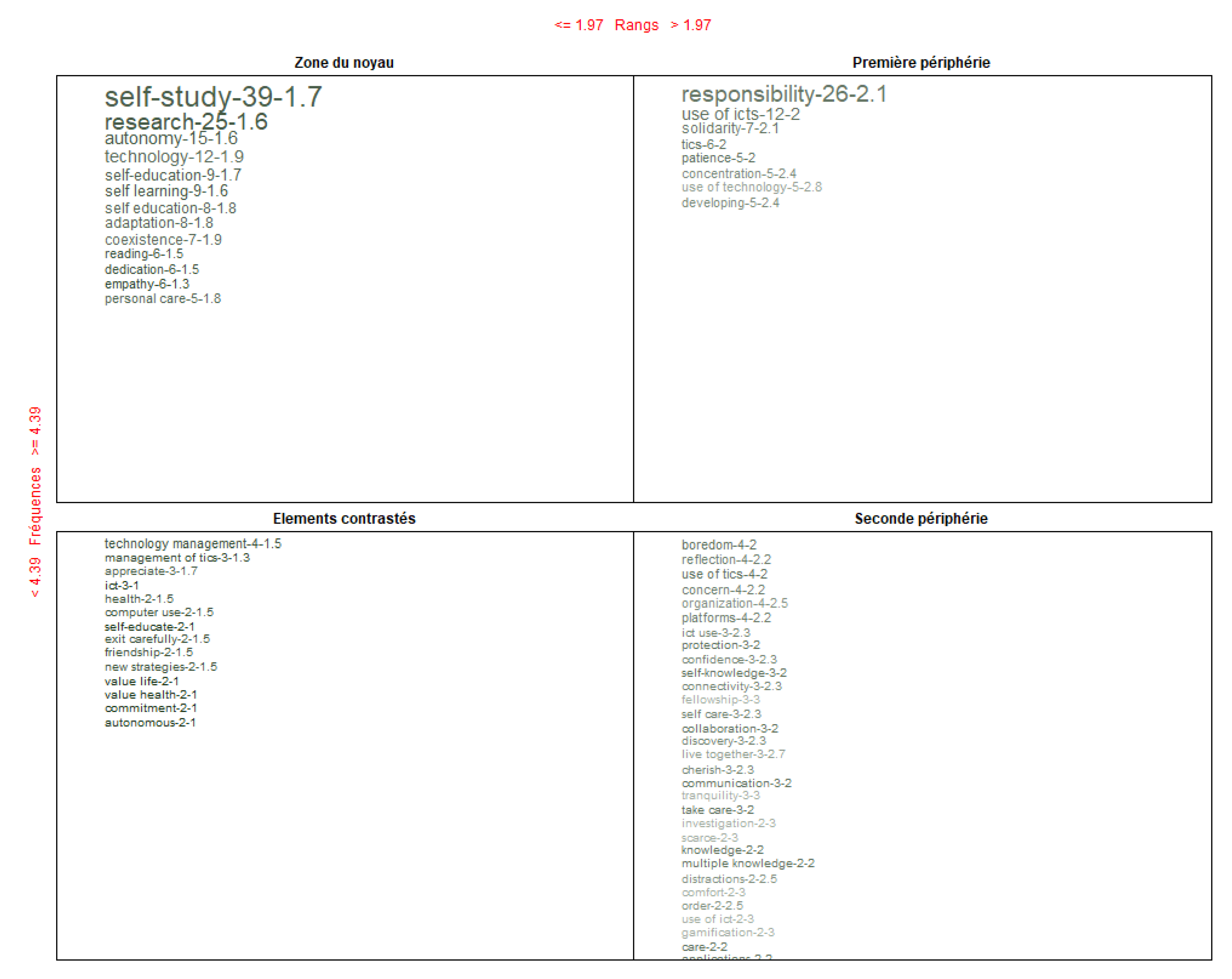COVID-19, Didactic Practices, and Representations Assumed by Preservice Teachers at Universidad Técnica del Norte-Ecuador
Abstract
1. Introduction
2. Materials and Methods
2.1. Stage 1: Development of the Instruments
2.2. Stage 2: Collection of Information
2.3. Stage 3: Data Analysis
2.4. Stage 4: Triangulation of Results
3. Results
3.1. About the Didactic Contents
3.1.1. Knowledge and Didactic Practice in the Contexts of COVID-19 and POS-COVID-19
3.1.2. Didactic Skills and Practice in the Contexts of COVID-19 and POS-COVID-19
3.1.3. Attitudes and Didactic Practice in the Contexts of COVID-19 and POS-COVID-19
3.2. About Organization
3.2.1. Virtual Didactic Practices and Representations during COVID-19
3.2.2. Face-to-Face Didactic Practices and Representations during POS-COVID-19
4. Discussion
4.1. About the Didactic Contents
- Does-not-answer, linked to the feeling of a sedentary lifestyle that generated instability. One study [43] revealed that confinement and its consequent increase in sedentary lifestyle could be related to increased psychological distress and stress, just as the following verbal association would confirm.
- Stress, associated primarily with concern and fear. This last association appears as a correlate of virtual interactions that, on multiple occasions, required meetings outside the regular schedule. For some authors, this situation could have increased psychological disorders in teachers and students [29,30,31,32,33].
4.2. About Organization
4.3. Strategies That Could Potentially Support the Implementation of Comprehensive Didactic Practices for Primary Education Students
5. Conclusions
6. Limitations and Future Lines of Research
Author Contributions
Funding
Institutional Review Board Statement
Informed Consent Statement
Data Availability Statement
Acknowledgments
Conflicts of Interest
References
- Melgarejo, X. Gracias, Finlandia. In Qué Podemos Aprender del Sistema Educativo de Más Éxito, 14th ed.; Plataforma Editorial: Barcelona, Spain, 2022; pp. 49–73. [Google Scholar]
- Rodríguez-Ponce, E.; Pedraja-Rejas, L.M.; Ganga-Contreras, F.A. Determinants, Processes and Results of the Teacher Education of Early Childhood Teachers and Primary Teachers in Chile: A Conceptual Approach. Form. Univ. 2019, 12, 127–140. [Google Scholar] [CrossRef]
- Pérez-González, A.B.; Vásquez Domínguez, C. Años veinte del veintiuno. La incidencia en España de la pandemia. In Cambio y Coronavirus. Representaciones Sociales. Burla, Silencio y Miedo, 1st ed.; Vásquez, C., Pérez-González, A., Salzano, D., Eds.; Publisher: Aula Magna, Spain, 2020; Volume 1, pp. 65–93. [Google Scholar]
- Sanlés Olivares, M. El Transhumanismo en 100 Preguntas, 1st ed.; Ediciones Nowtilus: Madrid, Spain, 2019; pp. 188–191. [Google Scholar]
- Blondeel, E.; Everaert, P.; Opdecam, E. And Then There Was COVID-19: Do the Benefits of Cooperative Learning Disappear When Switching to Online Education? Sustainability 2021, 13, 2168. [Google Scholar] [CrossRef]
- Pardeshi, S.; Gawade, S.; Hemant, P. Student learning time analysis during COVID-19 using linear programming—Simplex method. Soc. Sci. Humanit. Open 2022, 5, 100266. [Google Scholar]
- David, S.; Manea, L.D.; Virlanuta, F.O.; Bărbuță-Mișu, N.; Șorcaru, I.A. Higher Education Institution beyond the COVID-19 Pandemic—Evidence from Romania. Educ. Sci. 2022, 12, 693. [Google Scholar] [CrossRef]
- Butnaru, G.I.; Niță, V.; Anichiti, A.; Brînză, G. The Effectiveness of Online Education during COVID 19 Pandemic—A Comparative Analysis between the Perceptions of Academic Students and High School Students from Romania. Sustainability 2021, 13, 5311. [Google Scholar] [CrossRef]
- Gangahagedara, R.; Karunarathna, M.; Athukorala, W.; Subasinghe, S.; Ekanayake, P. Emergency Teaching–Learning Methods (ETLM) during COVID-19: Lessons Learned from Sri Lanka. Educ. Sci. 2021, 11, 579. [Google Scholar] [CrossRef]
- Iglesias-Pradas, S.; Hernández-García, Á.; Chaparro-Peláez, J.; Prieto, J.L. Emergency remote teaching and students’ academic performance in higher education during the COVID-19 pandemic: A case study. Comput. Hum. Behav. 2021, 119, 106713. [Google Scholar] [CrossRef] [PubMed]
- Hofer, S.I.; Nistor, N.; Scheibenzuber, C. Online teaching and learning in higher education: Lessons learned in crisis situations. Comput. Hum. Behav. 2021, 121, 106789. [Google Scholar] [CrossRef] [PubMed]
- Ubieto, J.R. El Mundo POS-COVID. Entre la Presencia y lo Virtual, 1st ed.; Ned Ediciones: Barcelona, Spain, 2021; pp. 115–119. [Google Scholar]
- Bygstad, B.; Øvrelid, E.; Ludvigsen, S.; Dæhlen, M. From dual digitalization to digital learning space: Exploring the digital transformation of higher education. Comput. Educ. 2022, 182, 104463. [Google Scholar] [CrossRef]
- Ng, L.-K.; Lo, C.-K. Flipped Classroom and Gamification Approach: Its Impact on Performance and Academic Commitment on Sustainable Learning in Education. Sustainability 2022, 14, 5428. [Google Scholar] [CrossRef]
- Morin, E. Cambiemos de vía. Lecciones de la Pandemia, 1st ed.; Editorial Planeta Colombiana S.A.: Bogotá, Colombia, 2021; pp. 47–58. [Google Scholar]
- Brown, J.; McLennan, C.; Mercieca, D.; Mercieca, D.P.; Robertson, D.P.; Valentine, E. Technology as Thirdspace: Teachers in Scottish Schools Engaging with and Being Challenged by Digital Technology in First COVID-19 Lockdown. Educ. Sci. 2021, 11, 136. [Google Scholar] [CrossRef]
- Pereira, Í.S.P.; Fernandes, E.L.; Flores, M.A. Teacher Education during the COVID-19 Lockdown: Insights from a Formative Intervention Approach Involving Online Feedback. Educ. Sci. 2021, 11, 400. [Google Scholar] [CrossRef]
- Tang, Y.M.; Chen, P.C.; Law, K.M.Y.; Wu, C.H.; Lau, Y.Y.; Guan, J.; He, D.; Ho, G.T.S. Comparative analysis of Student’s live online learning readiness during the coronavirus (COVID-19) pandemic in the higher education sector. Comput. Educ. 2021, 168, 104211. [Google Scholar] [CrossRef] [PubMed]
- Hadzigeorgiou, Y. Rethinking the Curriculum in the Context of Education for Sustainability: Lessons from the COVID-19 Pandemic. Educ. Sci. 2021, 11, 700. [Google Scholar] [CrossRef]
- Iqbal, S.A.; Ashiq, M.; Rehman, S.U.; Rashid, S.; Tayyab, N. Students’ Perceptions and Experiences of Online Education in Pakistani Universities and Higher Education Institutes during COVID-19. Educ. Sci. 2022, 12, 166. [Google Scholar] [CrossRef]
- Symes, W.; Lazarides, R.; Hußner, I. The development of student teachers’ teacher self-efficacy before and during the COVID-19 pandemic. Teach. Teach. Educ. 2023, 122, 103941. [Google Scholar] [CrossRef] [PubMed]
- Gonçalves, E.; Capucha, L. Student-Centered and ICT-Enabled Learning Models in Veterinarian Programs: What Changed with COVID-19? Educ. Sci. 2020, 10, 343. [Google Scholar] [CrossRef]
- Vijayan, R. Teaching and Learning during the COVID-19 Pandemic: A Topic Modeling Study. Educ. Sci. 2021, 11, 347. [Google Scholar] [CrossRef]
- Makgahlela, M.; Mothiba, T.M.; Mokwena, J.P.; Mphekgwana, P. Measures to Enhance Student Learning and Well-Being during the COVID-19 Pandemic: Perspectives of Students from a Historically Disadvantaged University. Educ. Sci. 2021, 11, 212. [Google Scholar] [CrossRef]
- Vishnu, S.; Raghavan Sathyan, A.; Funk, C.; Susan Sam, A.; Radhakrishnan, A.; Olaparambil Ragavan, S.; Vattam Kandathil, J. Digital Competence of Higher Education Learners in the Context of COVID-19 Triggered Online Learning. Soc. Sci. Humanit. Open 2022, 6, 100320. [Google Scholar]
- Bennett, R.; Uink, B.; Cross, S. Beyond the social: Cumulative implications of COVID-19 for first nations university students in Australia. Soc. Sci. Humanit. Open 2020, 2, 100083. [Google Scholar] [CrossRef]
- Navarro-Espinosa, J.A.; Vaquero-Abellán, M.; Perea-Moreno, A.-J.; Pedrós-Pérez, G.; Aparicio-Martínez, P.; Martínez-Jiménez, M.P. The Higher Education Sustainability before and during the COVID-19 Pandemic: A Spanish and Ecuadorian Case. Sustainability 2021, 13, 6363. [Google Scholar] [CrossRef]
- Almazova, N.; Krylova, E.; Rubtsova, A.; Odinokaya, M. Challenges and Opportunities for Russian Higher Education amid COVID-19: Teachers’ Perspective. Educ. Sci. 2020, 10, 368. [Google Scholar] [CrossRef]
- Etchells, M.J.; Brannen, L.; Donop, J.; Bielefeldt, J.; Singer, E.A.; Moorhead, E.; Walderon, T. Synchronous teaching and asynchronous trauma: Exploring teacher trauma in the wake of COVID-19. Soc. Sci. Humanit. Open 2021, 4, 100197. [Google Scholar] [CrossRef] [PubMed]
- León Gross, E. Consecuencias Psicológicas de la Pandemia. Vías de Solución, 1st ed.; Editorial LIBSA: Madrid, Spain, 2021; pp. 119–130. [Google Scholar]
- Han, B. Infocracia. La Digitalización y la Crisis de la Democracia, 1st ed.; Penguin Random House Grupo Editorial: Bogotá, Colombia, 2022; pp. 71–92. [Google Scholar]
- Yang, J.; Tian, Y. Others are more vulnerable to fake news than I Am”: Third-person effect of COVID-19 fake news on social media users. Comput. Hum. Behav. 2021, 125, 106950. [Google Scholar] [CrossRef]
- Han, B. No-Cosas. Quiebras del Mundo de Hoy, 1st ed.; Penguin Random House Grupo Editorial: Bogotá, Colombia, 2022; pp. 13–24. [Google Scholar]
- Celuch, M.; Savela, N.; Oksa, R.; Latikka, R.; Oksanen, A. Individual factors predicting reactions to online harassment among Finnish professionals. Comput. Hum. Behav. 2022, 127, 107022. [Google Scholar] [CrossRef]
- Sadin, É. La Humanidad Aumentada. La Administración Digital del Mundo, 1st ed.; Caja Negra Editora: Buenos Aires, Argentina, 2018; pp. 63–88. [Google Scholar]
- Sadin, É. La Inteligencia Artificial o el Desafío del Mundo. Anatomía de un Antihumanismo Radical, 1st ed.; Caja Negra Editora: Buenos Aires, Argentina, 2020; pp. 45–90. [Google Scholar]
- Sadin, É. La Siliconización del Mundo. La Irresistible Expansión del Liberalismo Digital, 1st ed.; Caja Negra Editora: Buenos Aires, Argentina, 2021; pp. 95–140. [Google Scholar]
- Moliner, P.; Lo Mónaco, G. Métodos de Asociación Verbal Para las Ciencias Humanas y Sociales. Fundamentos Conceptuales y Aspectos Prácticos, 1st ed.; Editorial Gedisa, S.A.: Barcelona, Spain, 2017; pp. 83–145. [Google Scholar]
- Cázares Hernández, L.; Christen, M.; Zamudio Rodríguez, L.E.; Villaseñor Roca, L. Investigación Documental. Técnicas y Aplicación, 1st ed.; Editorial Trillas, S.A.: Ciudad de México, Mexico, 2020; pp. 33–90. [Google Scholar]
- UTN. Código de Ética de la Universidad Técnica del Norte. 2012. Available online: https://bit.ly/3MW14AV (accessed on 12 December 2022).
- Sáez López, J.M.; Domínguez Garrido, M.C.; Medina Rivilla, A.; Ruiz Cabezas, A. Didáctica General. Formación Teórica y Práctica Para Educadores, 1st ed.; Editorial Universitas, S.A.: Madrid, Spain, 2021; pp. 209–212. [Google Scholar]
- Delors, J. La Educación Encierra un Tesoro, 1st ed.; Editorial Correo de la Unesco: Ciudad de México, Mexico, 2014; pp. 89–103. [Google Scholar]
- Rees-Punia, E.; Newton, C.C.; Westmaas, J.L.; Chantaprasopsuk, S.; Patel, A.V.; Leach, C.R. Prospective COVID-19 RelatedChanges in Physical Activity and Sedentary Time and Associations with Symptoms of Depression and Anxiety. Ment. Health Phys. Act. 2021, 21, 100425. [Google Scholar] [CrossRef] [PubMed]
- Walker, T.D. Enseñar Como en Finlandia. 33 Estrategias Sencillas Para Conseguir Más Felicidad en las Aulas, 1st ed.; Ediciones invisibles: Barcelona, Spain, 2018; pp. 147–182. [Google Scholar]
- Müller, A.M.; Goh, C.; Lim, L.Z.; Gao, X. COVID-19 Emergency eLearning and Beyond: Experiences and Perspectives of University Educators. Educ. Sci. 2021, 11, 19. [Google Scholar] [CrossRef]
- Srinivasan, S.; Ramos, J.A.L.; Muhammad, N. A Flexible Future Education Model—Strategies Drawn from Teaching during the COVID-19 Pandemic. Educ. Sci. 2021, 11, 557. [Google Scholar] [CrossRef]
- Fuertes-Camacho, M.T.; Dulsat-Ortiz, C.; Álvarez-Cánovas, I. Reflective Practice in Times of COVID-19: A Tool to Improve Education for Sustainable Development in Pre-Service Teacher Training. Sustainability 2021, 13, 6261. [Google Scholar] [CrossRef]
- Boström, L.; Collén, C.; Damber, U.; Gidlund, U. A Rapid Transition from Campus to Emergent Distant Education; Effects on Students’ Study Strategies in Higher Education. Educ. Sci. 2021, 11, 721. [Google Scholar] [CrossRef]
- Solberg, M.T.; Landfald, Ø.F.; Clarke, S.; Sørensen, A.L. Using a design-based research methodology to develop virtual reflection groups for Master’s students in nursing: An applied study. Soc. Sci. Humanit. Open 2022, 6, 100286. [Google Scholar]
- Kiernan, J.E. Pedagogical commentary: Teaching through a pandemic. Soc. Sci. Humanit. Open 2020, 2, 100071. [Google Scholar] [CrossRef]
- Sancho Larrañaga, R.; Riffo-Pavón, I. Análisis semiótico del discurso: Identificando representaciones e imaginarios sociales. In Investigación Sensible. Metodologías para el Estudio de Imaginarios y Representaciones Sociales, 1st ed.; Aliaga, F., Ed.; Universidad Santo Tomás: Bogotá, Colombia, 2022; Volume 1, pp. 120–151. [Google Scholar]
- Karasmanaki, E.; Tsantopoulos, G. Impacts of social distancing during COVID-19 pandemic on the daily life of forestry students. Child. Youth Serv. Rev. 2021, 120, 105781. [Google Scholar] [CrossRef] [PubMed]
- Zhao, Y.; Llorente, A.M.; Gómez, M.C. Digital competence in higher education research: A systematic literature review. Comput. Educ. 2021, 168, 104212. [Google Scholar] [CrossRef]
- Li, M.; Yu, Z. Teachers’ Satisfaction, Role, and Digital Literacy during the COVID-19 Pandemic. Sustainability 2022, 14, 1121. [Google Scholar] [CrossRef]
- Basantes-Andrade, A.; Casillas-Martín, S.; Cabezas-González, M.; Naranjo-Toro, M.; Guerra-Reyes, F. Standards of Teacher Digital Competence in Higher Education: A Systematic Literature Review. Sustainability 2022, 14, 3983. [Google Scholar] [CrossRef]
- Basantes-Andrade, A.; Cabezas-González, M.; Casillas-Martín, S. Competencias digitales en la formación de tutores virtuales en la Universidad Técnica del Norte, Ibarra-Ecuador. Form. Uni. 2020, 13, 269–282. [Google Scholar] [CrossRef]
- Beaunoyer, E.; Dupéré, S.; Guitton, M.J. COVID-19 and digital inequalities: Reciprocal impacts and mitigation strategies. Comput. Hum. Behav. 2020, 111, 106424. [Google Scholar] [CrossRef]








| Sex | Ethnic Self-Identification | Place of Residence | |||||||
|---|---|---|---|---|---|---|---|---|---|
| Female | Male | Mestizo | Indigenous | Afro Descendant | Other | Urban | Rural | Peripheral | |
| Frequency | 178 | 49 | 189 | 33 | 3 | 2 | 137 | 81 | 9 |
| Percentage | 78.4% | 21.6% | 83.3% | 14.5% | 1.3% | 0.9% | 60.3% | 35.7% | 4% |
| Informative Data | COVID-19, Didactic Practices, and Representations | |||||||||||||||||
|---|---|---|---|---|---|---|---|---|---|---|---|---|---|---|---|---|---|---|
| Before | After | |||||||||||||||||
| Contents | Organization | Contents | Organization | |||||||||||||||
| Participant | Level | Sex | Ethnicity | Age | Area | Province | Knowledge | Skills | Attitudes | Words (Frequency) | Range of appearance | Importance | Knowledge | Skills | Attitudes | Words (Frequency) | Range of appearance | Importance |
| S1 | First | Male | Mestizo | 23 | Rural | Imbabura | Virtual classes | Self-learning | Sadness | Use of technology | 1 | Positive | Efficiency | Dialogue | Tranquility | Live together | 2 | Neutral |
Disclaimer/Publisher’s Note: The statements, opinions and data contained in all publications are solely those of the individual author(s) and contributor(s) and not of MDPI and/or the editor(s). MDPI and/or the editor(s) disclaim responsibility for any injury to people or property resulting from any ideas, methods, instructions or products referred to in the content. |
© 2023 by the authors. Licensee MDPI, Basel, Switzerland. This article is an open access article distributed under the terms and conditions of the Creative Commons Attribution (CC BY) license (https://creativecommons.org/licenses/by/4.0/).
Share and Cite
Guerra-Reyes, F.; Naranjo-Toro, M.; Basantes-Andrade, A.; Guerra-Davila, E.; Benavides-Piedra, A. COVID-19, Didactic Practices, and Representations Assumed by Preservice Teachers at Universidad Técnica del Norte-Ecuador. Sustainability 2023, 15, 4770. https://doi.org/10.3390/su15064770
Guerra-Reyes F, Naranjo-Toro M, Basantes-Andrade A, Guerra-Davila E, Benavides-Piedra A. COVID-19, Didactic Practices, and Representations Assumed by Preservice Teachers at Universidad Técnica del Norte-Ecuador. Sustainability. 2023; 15(6):4770. https://doi.org/10.3390/su15064770
Chicago/Turabian StyleGuerra-Reyes, Frank, Miguel Naranjo-Toro, Andrea Basantes-Andrade, Eric Guerra-Davila, and Andrés Benavides-Piedra. 2023. "COVID-19, Didactic Practices, and Representations Assumed by Preservice Teachers at Universidad Técnica del Norte-Ecuador" Sustainability 15, no. 6: 4770. https://doi.org/10.3390/su15064770
APA StyleGuerra-Reyes, F., Naranjo-Toro, M., Basantes-Andrade, A., Guerra-Davila, E., & Benavides-Piedra, A. (2023). COVID-19, Didactic Practices, and Representations Assumed by Preservice Teachers at Universidad Técnica del Norte-Ecuador. Sustainability, 15(6), 4770. https://doi.org/10.3390/su15064770








